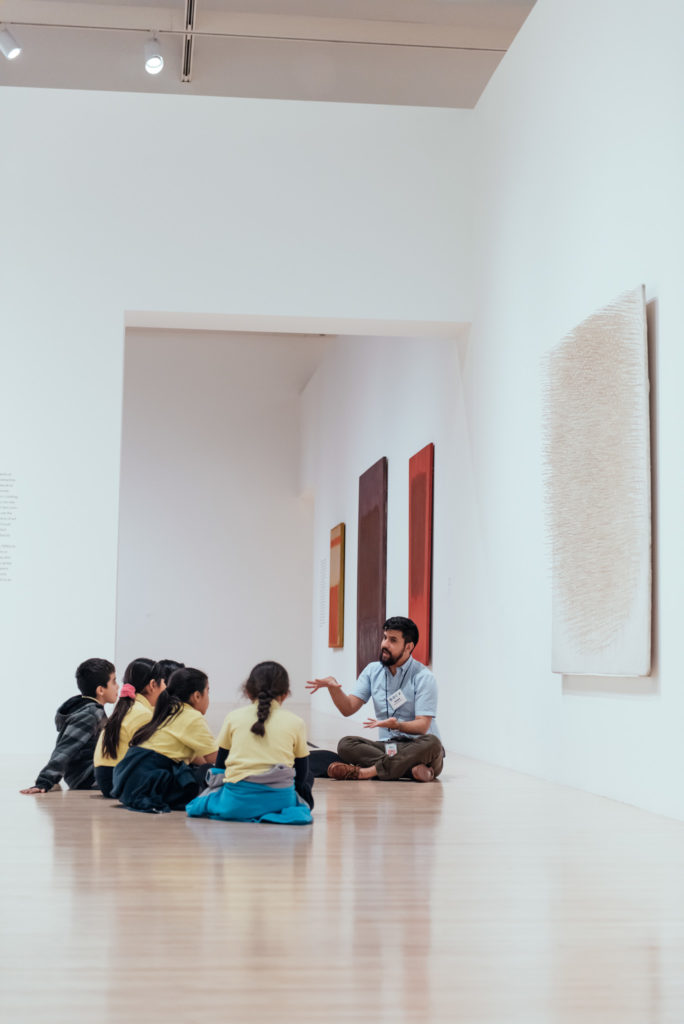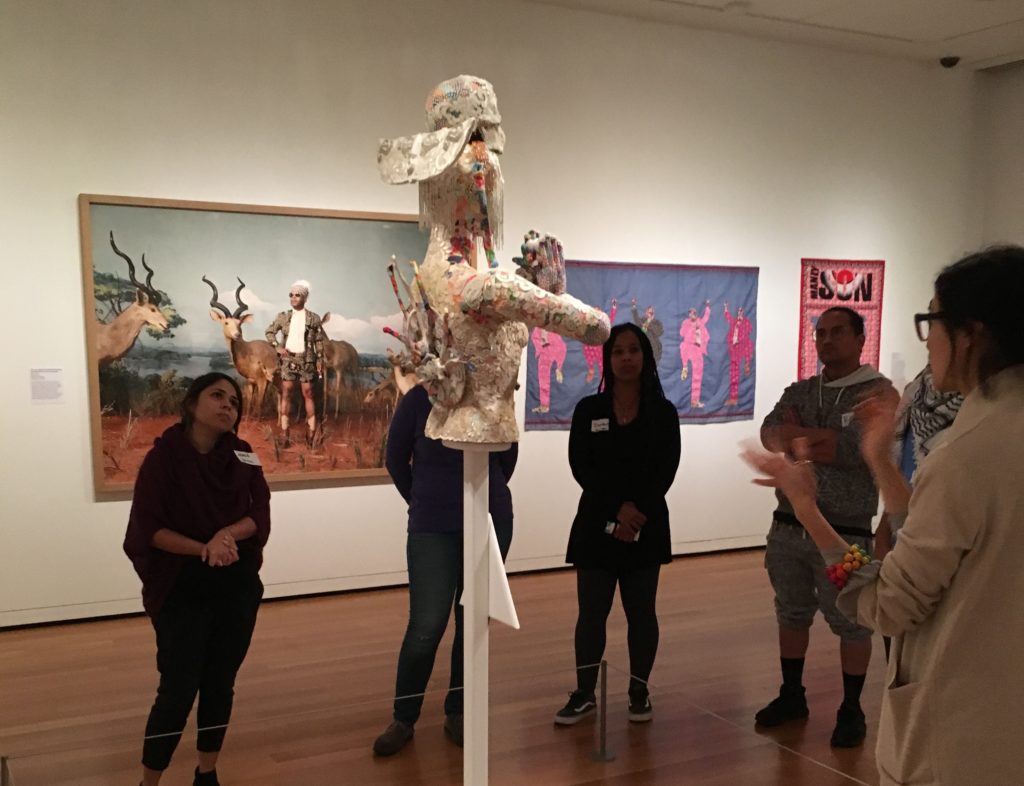As both a learner and a teacher, I have had few experiences participating in learning environments exclusively for people of color (POC) until recently. 1 One strong memory I have is from several years ago in my previous work as an educator at The Museum of Contemporary Art, Los Angeles (MOCA). I was facilitating a Visual Thinking Strategies (VTS) discussion of Jasper Johns’s Map (1962) as part of a tour of the museum for a group of elementary students who were all Latinx. I, myself, am mixed race, of South Asian and white descent. At one point in the discussion, one of the students noticed the unprimed, unpainted canvas at the bottom of the painting. She described the beige, peach color of the unprimed canvas as “skin colored.”
In Visual Thinking Strategies, facilitators paraphrase every comment a student makes about the picture being discussed. As I listened to that comment, I tried to process how I might paraphrase it. I looked at the color she was describing in the painting, then looked down at my brown-skinned hands, and at the skin color of my students’ faces, and I felt a strong disconnect between the comment the student had just made and all of our lived experiences as brown-skinned people. After a few moments of processing, I settled on the paraphrase, “the color of some people’s skin.”
Later on, as I continued to reflect on the choices I made to paraphrase that student’s comment, I thought about how it might have impacted the conversation if, perhaps in a joking manner, I had added, “but that’s not the skin color any of us has.” I would not have wanted my student to feel like I was judging her or her comment. But what I tried to do in my paraphrase (which this interjection might have made more explicit) was to help the student become aware that she was describing a particular color as “skin color” that excluded her and all of us in our group. Calling attention to our shared brown skin could have been an opportunity to reinforce students’ positive perceptions of themselves and their identities.
This small example provides some insight into the fact that structures in American society center whiteness, often without naming or acknowledging that whiteness. Thus, my student learned to use the term “skin colored” to describe the color of white people’s skin rather than the hue of her own skin. Whiteness is often accepted as the unchallenged norm.
Even 65 years after the Brown v. Board of Education ruling, most schools in the United States are de facto segregated—this was likely true for the group I taught at MOCA. De facto segregation perpetuates inequities in education. Aaliyah El-Amin, an education scholar whose expertise is education for African American students that promotes societal change, writes, however, that when separated educational settings are used intentionally, they can be essential for strong racial identity development. 2 For adult antiracist learning, Robin DiAngelo also suggests that discussing issues of race and racism in affinity groups based on race is beneficial for both participants of color and white participants. 3 Thus, both El-Amin and DiAngelo offer examples of how intentional separation can be used as a tool to decenter whiteness.

The author leads a VTS discussion-based tour of students at The Museum of Contemporary Art (MOCA), Los Angeles. Photo by Nico Therin, Courtesy of the Museum of Contemporary Art, Los Angeles Education Department
In October 2018, Visual Thinking Strategies Program Director Yoon Kang-O’Higgins and I led the first VTS Beginner Practicum exclusively for people of color in partnership with the Seattle Art Museum. As a pilot program, participation was invitation only and free of charge. Yoon and I made no changes to the content or structure of a typical Beginner Practicum, which is the first in the series of VTS national trainings. But since all VTS trainings center participants and are responsive to their questions, we found that the experiences our group brought to the workshop made it qualitatively different from other trainings we have led. For me, the experience drove home why it’s so important for educators of color to have intentional spaces to learn and reflect exclusively with other POCs. Based on the questions our participants brought, and the discussions we had, it also helped illuminate the potential for VTS to be used in conjunction with antiracist pedagogy.
Race scholars often define racism as prejudice plus power on a systemic level. 4 To be antiracist means that you are actively working to dismantle systems that reinforce societal power for white people over people of color, or in other words, systems that uphold white supremacy. 5 When in an intentional POC-only learning environment, participants have the potential to connect with and learn from others who have shared lived experiences and to develop tools for combating racism. 6
VTS seeks to create an equitable learning environment, but it is not explicitly an antiracist curriculum. In my paraphrase of my student’s comment at MOCA, I sought to be antiracist and to decenter whiteness in that moment by calling attention to the fact that the color we were looking at could only be accurately described as “the color of some people’s skin.” Another facilitator might have chosen to paraphrase the same comment using other language, such as “peach” or “beige,” without offering the nuance that the color described is not the universal color of skin. Such a paraphrase would have fulfilled what the VTS method asks facilitators to do, but would not have helped the student think about her choice of words and their meaning.
So why then learn VTS only with other educators of color? The POC Beginner Practicum originated as an attempt to address that as a field, museum education is white dominated and most participants of VTS national trainings tend to be white. While one two-day workshop could not drastically change these facts, we wanted to take steps to enact change of who participates in and who facilitates VTS discussions. Yoon Kang-O’Higgins of VTS approached Regan Pro, the Kayla Skinner Deputy Director for Education & Public Engagement at the Seattle Art Museum, and she was immediately interested in partnering, as the premise for the workshop aligned closely with the museum’s commitment to equity. 7

Three participants of the POC Beginner Practicum take a silent moment to look before discussing artworks in the galleries of the Seattle Art Museum.
As Yoon and I invited colleagues to participate in this program, we were explicit that it was for educators who identified as POC. This helped make the objective clear to all participants that we were intentionally coming together as a group of educators of color to learn VTS. Our group included artists, museum educators, poets, activists, community organizers, a yoga instructor, and social justice consultants. Our group’s makeup informed how the training unfolded. Many participants were facilitators in other aspects of their work and were already keen, active listeners who excelled at paraphrasing the first time they tried facilitating a VTS conversation.
The questions that came up in group conversations were not the typical ones that come up in Beginner Practicums. While Yoon and I did not alter the images and prompts that are usually part of such trainings, members of the group brought what was important to them to the center. Participants offered critiques of how the VTS method and curriculum may center whiteness. As an organization, VTS recognizes that white dominant culture shaped the method and curriculum as it was originally formed. As a collective of trainers, we are dedicated to striving towards racial equity and open to rethinking how we structure trainings and curriculum to support that. One participant focused our attention on who is represented in the curriculum and who is not. We are in the process of developing and launching new curriculum sets that among other concerns are culturally responsive to our teachers’ students.

Participants of the POC Beginner Practicum consider works they might discuss for practice VTS conversations.
Another participant brought up that the act of a teacher or facilitator paraphrasing someone else’s ideas in their words could feel colonialist. There is no easy answer to that critique. Facilitators must be mindful that they are listening to their students and interpreting their comments through the lens of their own lived experience. That is why when teachers—of any race, though most often they are white—ask for tools to use VTS to hold potentially difficult conversations in their classrooms, our recommendation as trainers is, in the words of Dr. Steven Jones, a nationally recognized diversity and inclusion expert, to “skill up.” By this we mean that there is no shortcut to learning to become an antiracist educator. Every person must devote time to their own learning about issues that might impact a conversation about race. Although this is not always the case, educators of color have often spent more time thinking about issues of race and racism than white educators because of our experiences being racialized in a white-dominated society. The more one has actively engaged in thinking and talking about societal racial inequities, the more prepared one is to paraphrase a student comment that explores those issues.

VTS Program Director Yoon Kang-O’Higgins (right) facilitates a discussion in the Seattle Art Museum galleries as a model for participants of the POC Beginner Practicum at the beginning of the second day of the workshop.
Six months after the workshop, I asked two participants to reflect on the value of learning VTS exclusively with people of color. Maria Reyna, Museum Educator, Bill & Melinda Gates Foundation Discovery Center, wrote:
For me, there was a different level of ease in sharing a learning space with other POC individuals. From the beginning of the workshop, there seemed to be an unspoken understanding that VTS is a practice that centers the human experience, not the art. The museum became just a minor character in the background. We were here to understand an approach to facilitation that would help us show up for one another. To be heard, understood, and allow our peers to cultivate their own personal connection to the work in front of us and to each other. 8
Pamela Maldonado, another Seattle-based museum educator, honed in on this:
For me it was important to learn VTS in a POC-only space because it allowed for a level of comfort and understanding that would not have taken place in other spaces. Especially when we were looking at pieces of artwork that had POCs in them…. It felt like folks shared more openly about what they were seeing, but also about themselves. Whereas in other spaces there might have been a need to intervene around potentially hurtful comments or stereotypes. Overall it was an opportunity that felt empowering because most of my time as a museum educator I am working in majority non-POC spaces. 9
Much like Maria and Pamela, I felt a different level of comfort as a trainer co-leading the POC Beginner Practicum. Early on in the workshop, one participant appreciated how validating it felt having another participant use our names as he called on us to speak and paraphrased our ideas. She pointed out how powerful that was particularly for us, since many of us in our smaller group had names that often get mispronounced. As she said that, I looked around our group and at our nametags confirming that for myself, and I felt at once a kinship and belonging in that shared experience that I rarely feel. If we continue to practice VTS in learning environments exclusively for people of color, there is the potential for more experiences like this, where participants feel at ease and understood in ways they don’t in mixed spaces.
